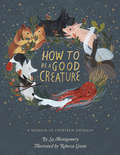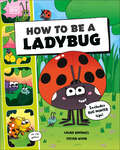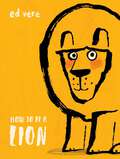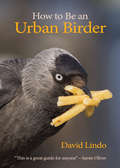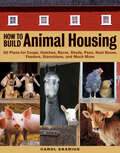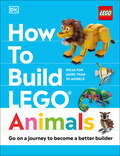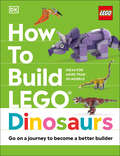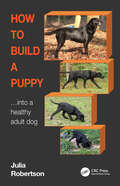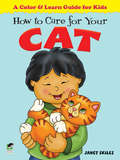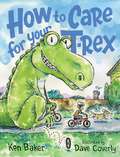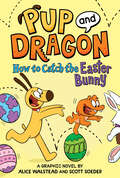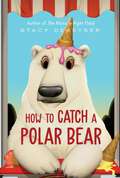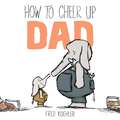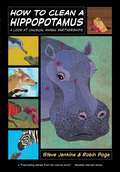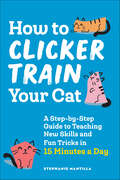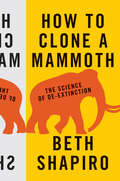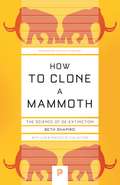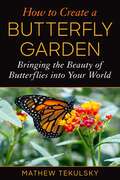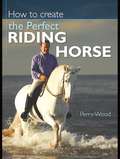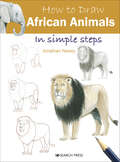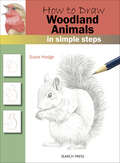- Table View
- List View
How to Be a Cat
by Nikki McClure“The simplicity and flow of page design are beautifully done as viewers follow a kitten and his mother as she teaches him basic feline behavior.” —School Library Journal (starred review)In cut-paper artist Nikki McClure’s latest picture book, a kitten practices the basics of feline behavior over the course of a day. A single word of text per spread teaches readers “how to be a cat”—how to stretch, clean, pounce, feast—while the striking paper cuts illustrate the kitten’s attempts to imitate an adult cat’s mastery of each skill. At times the kitten triumphantly succeeds, and at other times the kitten struggles, in vignettes that range from whimsical to profound.A celebration of all things feline, How to Be a Cat also tells a universal story of mastering life skills, and of the sometimes tender, sometimes stern relationship between parent and child, teacher and pupil. Cat lovers of all ages will connect to this loving portrayal of a mentor-student relationship.“Purrrrfect for beginning readers and little artists with an eye for fine cut-paper compositions and craftsmanship.” —Kirkus Reviews (starred review)“The lively verbs and pictures will inspire young readers to imitate the kitten’s actions, all the way to the last page, when the two cats curl up to ‘Dream.’ Part concept book of actions, part a day in the life of a cat, the pages provide two kinds of narratives, no small feat for such a simple-looking story.” —New York Journal of Books“McClure’s cut-paper spreads can be mesmerizing.” —Publishers Weekly“McClure wonderfully captures the shape and movement of the feline form.” —The Bulletin of the Center for Children’s Books
How to Be a Good Creature: A Memoir in Thirteen Animals
by Sy MontgomeryA New York Times bestseller! National Book Award finalist Sy Montgomery reflects on the personalities and quirks of 13 animals—her friends—who have profoundly affected her in this stunning, poetic, and life-affirming memoir featuring illustrations by Rebecca Green. Understanding someone who belongs to another species can be transformative. No one knows this better than author, naturalist, and adventurer Sy Montgomery. To research her books, Sy has traveled the world and encountered some of the planet’s rarest and most beautiful animals. From tarantulas to tigers, Sy’s life continually intersects with and is informed by the creatures she meets. This restorative memoir reflects on the personalities and quirks of thirteen animals—Sy’s friends—and the truths revealed by their grace. It also explores vast themes: the otherness and sameness of people and animals; the various ways we learn to love and become empathetic; how we find our passion; how we create our families; coping with loss and despair; gratitude; forgiveness; and most of all, how to be a good creature in the world.
How to Be a Ladybug (How to Be a Bug)
by DKShrink to the size of a garden bug and enter the world of ladybug in this first graphic novel for children.This graphic novel of garden life, made in collaboration with the Royal Entomological Society, is a perfect introduction to ladybugs for bug-obsessed little ones aged 5-7.Follow a newly hatched ladybug as she learns the ins and outs of ladybughood, and meet plenty of fascinating bug characters along the way, in this first graphic novel. Narrated by a wise old grasshopper, offering tips and tricks on how to be a ladybug, children will love to follow the story of Dotty the larva. This bug book for children offers: A graphic novel format to engage children in non fiction topics.Content made in partnership with the Royal Entomological Society providing scientific information about insects.An engaging story about a newly hatched larva, Dotty, as she learns how to navigate life as a ladybug.Our tale begins with a cluster of tiny eggs resting peacefully on a leaf–but life for a ladybug larva is far from peaceful. There are dastardly harlequins to contend with and giant predators in the form of birds. Not to mention the confusing fact that our leading larva doesn’t look anything like a ladybug at all! With transformations to look forward to–including gaining a pair of wings–and plenty of friendly bugs to meet, our heroine will soon learn that life in the garden isn’t all bad.
How to Be a Lion
by Ed VereFrom the New York Times bestselling author/illustrator of Max the Brave comes an inspiring and adorable picture book about a pair of unlikely friends who face down a pack of bullies. In this timely and charming story about the importance of being true to yourself, mindfulness, and standing by your friends, we meet Leonard, a lion, and his best friend Marianne, a . . . duck.Leonard and Marianne have a happy life together—talking, playing, writing poems, and making wishes, But one day, a pack of bullies questions whether it's right for a lion and a duck to be pals. Leonard soon learns there are many ways to be a lion, and many ways to be a friend, and that sometimes finding just the right words can change the world . . . This sweet, funny, thoughtful, and much-needed story will open up readers' eyes to the importance of being who they are and not backing down to hurtful criticism. It's an empowering tale about connecting with others and choosing kindness over bullying, and shows children how angry and provocative words can be overcome by empathy and inner courage.
How to Be an Urban Birder (Wildguides Ser. #13)
by Jamie Oliver David LindoThe first guide to urban birding in the UK, from The Urban Birder himself, David LindoUrban birding is fast becoming ornithology’s new rock ’n’ roll. Birds and birding have never been cooler—and urban birding is at the cutting edge.How to Be an Urban Birder is the world’s first guide to the art of urban birding—which is so easy and great fun! Here, urban birding pioneer David Lindo tells you everything you need to know about birds and birding in towns and cities in the UK.Includes a brief history of urban birding in the UKCovers the best places to look for birds in towns and citiesHelps you get to know your urban birdsGives useful tips on how to attract birds to your gardenExplains what gear you need and how to go about being an urban birderFeatures hundreds of cool images and illustrations of birds in urban settings
How to Build Animal Housing: 60 Plans for Coops, Hutches, Barns, Sheds, Pens, Nestboxes, Feeders, Stanchions, and Much More
by Carol EkariusWith dozens of adaptable plans for sheds, coops, hutches, multipurpose barns, windbreaks, and shade structures, this guide covers everything you need to know to build safe and sturdy housing for your animals. Stressing the importance of evaluating your goals, planning ahead, and budgeting accordingly, Carol Ekarius helps you determine the best structure for your particular situation and offers expert advice on tools and construction techniques. Build a functional and comfortable house for your animals that they’ll be proud to call home.
How to Build LEGO Animals: Go on a Journey to Become a Better Builder (How to Build LEGO)
by Hannah Dolan Jessica FarrellDiscover how to build your own awesome LEGO® Animals!Be inspired by 30 incredible LEGO animals, from a roaring lion to a multi-colored turtle. Embark on an imaginative building journey as the models get more challenging through the book. Each animal idea is broken down into three, four, or five important building steps.Learn essential building techniques to create claws and teeth, legs and tails, textures and colors and much more, for your own wonderful creations.You can build anything! ©2023 The LEGO Group.
How to Build LEGO Dinosaurs (How to Build LEGO)
by Hannah Dolan Jessica Farrell Nathan DiasDiscover how to build your own awesome LEGO® dinosaurs!Be inspired by 30 incredible LEGO dinosaurs and prehistoric creatures, from a fierce T-rex to a giant Brachiosaurus, a winged Pteranodon and so much more. Each dinosaur idea is broken down into three, four, or five important building steps.Learn essential building techniques to create claws and teeth, legs and tails, textures and colors and much more, for your own wonderful creations. Embark on an imaginative building journey as the models get more challenging through the book.How to Build LEGO Dinosaurs features:- Clear images and easy-to-follow visual breakdowns of key parts of the models allow anyone to feel confident building the creations.- Fifteen &“Accessory&” feature pages highlight a key technique, part of a dinosaur or its environment (e.g. teeth and claws, eggs, habitat, prehistoric plants, fossils, horns and spines), so that the reader hones their building skills as they go through the book.-Tips throughout from LEGO expert builders.Ideal for LEGO lovers aged 7–9, including children who are new to LEGO building and who want to learn the basics, as well as more experienced LEGO builders who would like inspiration for exciting house models. You can build anything!
How to Build a Puppy: Into a Healthy Adult Dog
by Julia RobertsonDogs do not demonstrate discomfort or pain in a way that can be easily translated by us humans, so we often miss that they are physically struggling. Understanding that making some very simple changes to our homes, activities, exercise regimes and how we train our puppies will have a massive positive impact on our dogs' lives. Using her world-renowned Galen Myotherapy knowledge and approach, Robertson suggests and explains in detail how small, profoundly important but easy to implement changes can improve the way we not only look after and develop our puppies but also how maintenance of this easy programme continues your puppy’s journey through into healthy adolescence and maturity. Environment, exercise and activity habits have deep, ongoing effects and How to Build a Puppy ... into a healthy adult dog explores ways in which positive change can be integrated easily into our normal lives. The book culminates into a full programme called the Galen Myotherapy Puppy Physical Development Programme©. Including: A dedicated section on anatomy, explaining in a functional way how everything in the body interrelates to form a functional moving structure Practical advice that is made logical and easy to interpret by the use of clear comparative descriptions as well as clear diagrams and pictures showing the movement and biomechanics of dogs Exercises and activities in a practical programme, for all situations, that can be followed to help build good foundations A full pictorial explanation of why so many 'traditional' exercise routines and activities are in fact incredibly damaging for our dogs This book will help canine professionals better advise their clients, but also empower all readers to make their own changes, as well as having a better all-round understanding to enable more pertinent questions from their vet, breeder or puppy trainer.
How to Care for Your Cat: A Color & Learn Guide for Kids (Dover Children's Activity Books)
by Janet SkilesThis coloring book is a fun-to-follow guide for every family that owns a cat or is considering adopting one. Simple pictures and clear, concise captions teach smart, safe ways for children to interact and bond with their pets. Tips include the importance of vaccinations, fresh water and food, and litter-box cleanliness, as well as suggestions for grooming and training.
How to Care for Your T-Rex
by Ken BakerFind out how to babysit a dinosaur in How to Care for Your T-Rex, a very funny read-aloud picture book from writer Ken Baker and illustrator Dave Coverly. There are a few important things to know about your pet T-Rex:What does it like to eat? Your T-Rex will eat approximately 300 pounds of food each day. Where will it have space to exercise? Your T-Rex can cover fifteen feet in a single step. How do you brush its many teeth? Especially when those teeth are nine inches long.And, most of all, how do you show your T-Rex that you love it? Get ready for a day full of giant adventures in dinosaur care!Christy Ottaviano Books
How to Catch Graphic Novels: How to Catch the Easter Bunny (How to Catch Graphic Novels)
by Alice WalsteadFrom the creators of the New York Times and USA Today bestselling How to Catch series comes a new exhilarating graphic novel adventure!Pup has boundless energy and endless optimism; Dragon is cool and thoughtful but always up for adventure...together, they are best friends who are always there for one another. In their bounciest adventure, Pup and Dragon are trying to catch the Easter Bunny!Bursting with colorful art and hilarious text, Pup and Dragon: How to Catch the Easter Bunny is sure to appeal to How to Catch lovers and new young readers alike.More Pup and Dragon Adventures:Pup and Dragon: How to Catch an ElfPup and Dragon: How to Catch a DinosaurPup and Dragon: How to Catch a Unicorn
How to Catch a Polar Bear (Washington Park Stories)
by Stacy DeKeyserIn this &“funny and heartwarming&” (Booklist) historical fiction companion to The Rhino in Right Field, Nick&’s summer gets way more exciting when a polar bear escapes from the local zoo—perfect for fans of Stuart Gibbs and The One and Only Ivan.It&’s 1948, and twelve-year-old Nick is ready for the best summer ever. He&’s going to hang out with his best pal, Ace, and maybe with Penny too—she is a girl, but she has a great throwing arm. Then things get wild when a polar bear escapes from Milwaukee&’s city zoo and appears right on his block. They&’re all going to have to keep their eyes open now. But Nick&’s grand plans start to crumble when Ace gets a paper route and Penny decides to share it with him. Now they&’re never around. Nick himself is working at his Uncle Spiro&’s frozen custard shop, but at least he gets free all-you-can-eat dessert. When Uncle Spiro opens a custard stand at the zoo, Nick volunteers to help—if that polar bear escapes again, he&’ll have a front row seat! But their competitor, Happy Harold, opens a stand of his own right outside the zoo. Now Nick is scrambling to keep their customers, especially because Happy keeps playing dirty tricks. When Penny discovers that someone may have let the polar bear out on purpose, Nick suspects that Happy might be involved. With mysteries to solve and a whole zoo-full of monkey business, it looks like Nick&’s summer won&’t be so boring after all!
How to Cheer Up Dad
by Fred KoehlerA hilarious book about parent and child relationships for fans of Ian Falconer and Jon Agee--a perfect gift idea for Father's Day and beyond!Little Jumbo just can't understand why his dad is having such a bad day. It couldn't be the raisins Little Jumbo spit out at the ceiling or the bath he refused to take--after all, Little Jumbo's dad knew he hated raisins and had already taken a bath that week! Luckily, Little Jumbo is such a thoughtful elephant that he decides to turn his dad's bad day around with some of his--ahem, his dad's--favorite things.How to Cheer up Dad is a standout debut featuring a charmingly oblivious little elephant with serious pluck and staying power. It turns the parent-child roles upside down is a great book for dads and the kids who make them laugh.
How to Clean a Hippopotamus: A Look at Unusual Animal Partnerships
by Steve Jenkins Robin PageHow to Clean a Hippopotamus, a book about animal symbiosis, offers readers a close-up, step-by-step view of nature’s fascinating partnerships. Find out why a mongoose comes running when a warthog lies down, how a crab and an iguana help each other out, why ravens follow wolves, and more.
How to Clicker Train Your Cat: A Step-by-Step Guide to Teaching New Skills and Fun Tricks in 15 Minutes a Day
by Stephanie MantillaClicker train your cat in just 15 minutes a day with this easy-to-use guideClicker training uses positive reinforcement to teach your cat new skills, encourage good behavior, and correct undesirable behavior. How to Clicker Train Your Cat makes cat training easy with short, targeted lessons that teach everything from basic commands to fun tricks. Just communicate the desired behavior, click, and give your cat a treat—it's that simple!This guide to cat training includes:A progressive approach—Start small with essential commands and practical skills that serve as a foundation for additional training, solving behavioral problems, and bonding through play.Step-by-step instructions—Find clear directions that break down each cat training lesson into small steps so both you and your cat feel confident and comfortable.Cat communication basics—Learn what your cat is telling you through their body language, facial expressions, and vocalizations, and how their unique traits require training them differently than other animals.Build a stronger connection and improve your cat's behavior with this positive approach to cat training.
How to Clone a Mammoth
by Beth ShapiroCould extinct species, like mammoths and passenger pigeons, be brought back to life? The science says yes. In How to Clone a Mammoth, Beth Shapiro, evolutionary biologist and pioneer in "ancient DNA" research, walks readers through the astonishing and controversial process of de-extinction. From deciding which species should be restored, to sequencing their genomes, to anticipating how revived populations might be overseen in the wild, Shapiro vividly explores the extraordinary cutting-edge science that is being used--today--to resurrect the past. Journeying to far-flung Siberian locales in search of ice age bones and delving into her own research--as well as those of fellow experts such as Svante Pääbo, George Church, and Craig Venter--Shapiro considers de-extinction's practical benefits and ethical challenges. Would de-extinction change the way we live? Is this really cloning? What are the costs and risks? And what is the ultimate goal? Using DNA collected from remains as a genetic blueprint, scientists aim to engineer extinct traits--traits that evolved by natural selection over thousands of years--into living organisms. But rather than viewing de-extinction as a way to restore one particular species, Shapiro argues that the overarching goal should be the revitalization and stabilization of contemporary ecosystems. For example, elephants with genes modified to express mammoth traits could expand into the Arctic, re-establishing lost productivity to the tundra ecosystem. Looking at the very real and compelling science behind an idea once seen as science fiction, How to Clone a Mammoth demonstrates how de-extinction will redefine conservation's future.
How to Clone a Mammoth: The Science of De-Extinction (Princeton Science Library #108)
by Beth ShapiroAn insider's view on bringing extinct species back to lifeCould extinct species, like mammoths and passenger pigeons, be brought back to life? In How to Clone a Mammoth, Beth Shapiro, an evolutionary biologist and pioneer in ancient DNA research, addresses this intriguing question by walking readers through the astonishing and controversial process of de-extinction. From deciding which species should be restored to anticipating how revived populations might be overseen in the wild, Shapiro vividly explores the extraordinary cutting-edge science that is being used to resurrect the past. Considering de-extinction's practical benefits and ethical challenges, Shapiro argues that the overarching goal should be the revitalization and stabilization of contemporary ecosystems. Looking at the very real and compelling science behind an idea once seen as science fiction, How to Clone a Mammoth demonstrates how de-extinction will redefine conservation's future.
How to Create a Butterfly Garden: Bringing the Beauty of Butterflies into Your World
by Mathew TekulskyAuthor Mathew Tekulsky wrote the first book on butterfly gardening for North America, nearly 40 years ago! Butterfly gardening is the practice of attracting beautiful butterflies to your garden by growing common plants and flowers that they use for food and nectar. This fun and wonderfully simple activity will bring color, light, and beauty to your garden and home. With the relaxing and rewarding qualities of this outdoor hobby, it&’s not hard to see why it&’s sweeping the nation and growing in popularity.How to Create a Butterfly Garden is a complete, step-by-step guide to gardening for butterflies. You&’ll learn about: The butterfly life cycle, habitats, and behaviorsChoosing and obtaining food and nectar sourcesDesigning your gardenOptions for country, suburban, and city gardensFifty common garden butterflies and the plants they likeButterfly observation and conservation This guide will teach you everything you need to get started—whether you&’re a suburban resident, the owner of a small urban garden, an apartment dweller, or a keeper of a country estate, you can enjoy frequent butterfly visits to your garden or window box. The key, Tekulsky believes, is learning some basic knowledge of butterfly characteristics and behavior and knowing how to meet the needs of the butterfly species most common in your neighborhood. Not only is butterfly gardening one of the easiest ways to enjoy these enchanting creatures, but it&’s also a wonderful way to help conserve natural butterfly populations for generations to come. Learn how to create your own beautiful butterfly garden today!
How to Create the Perfect Riding Horse
by Perry WoodAn honest and encouraging guide for everyone who wishes their horse could be the perfect riding horse Essential tools and clear step-by-step photography for training the horse and rider help you create your perfect riding horse for any discipline or level of ability Inspirational advice and ingenious tips take you through choosing the right horse, mastering the basics of groundwork, schooling and introducing jumping Perry Wood's skill as a coach of both horses and people puts these effective methods within easy grasp of everyone, transforming any rider into a real trainer
How to Create the Perfect Riding Horse
by Perry WoodAn honest and encouraging guide for everyone who wishes their horse could be the perfect riding horse Essential tools and clear step-by-step photography for training the horse and rider help you create your perfect riding horse for any discipline or level of ability Inspirational advice and ingenious tips take you through choosing the right horse, mastering the basics of groundwork, schooling and introducing jumping Perry Wood's skill as a coach of both horses and people puts these effective methods within easy grasp of everyone, transforming any rider into a real trainer
How to Draw a Brave Chicken
by Ethan T. BerlinAnother "How to Draw" lesson spins hilariously out of control in this sequel to How to Draw a Happy Cat, perfect for fans of We Don't Eat Our Classmates and Dragons Love Tacos.Follow these simple instructions for drawing a brave chicken: Draw an oval, two dots for eyes, triangles for the beak, lines for legs, and some wings. Easy enough. But wait . . . where is the chicken? Oh, she&’s hiding! Maybe she needs armor to feel brave . . . so let&’s draw her some shiny armor. Now she&’s feeling brave—and she wants to chase a dragon! Oh no, Chicken! Are you sure you want to do that?Kids and adults will have a ball watching the gang from How to Draw a Happy Cat go off the rails again! Comedian and author, Ethan T. Berlin and wicked-funny illustrator Jimbo Matison team up once again in the perfect follow up to continue the fun.
How to Draw a Happy Cat
by Ethan T. BerlinA "How to Draw" lesson spins hilariously out of control when Cat just won't stay happy! This relatable madcap read-aloud is immense fun, and perfect for fans of Dragons Love Tacos.Drawing a happy cat seems like such an easy thing to do. Just follow the instructions in this book! Wait a minute . . . why doesn't Cat look happy? We gave her a stuffy and a cool t-shirt! Uh-oh! Turns out drawing a happy cat is harder than it looks. Now it's the reader's job to find out why Cat isn't staying happy AND draw everything she wants! (That might include skateboards, friends, and yes--even a pizza-flinging catapult.) This clever, often tender, laugh-out-loud picture book breaks the fourth wall in charming ways; will have kids asking for repeat reads; and will defintely have parents nodding knowingly at the escalating cycle of demands. Can you draw a happy cat?
How to Draw: African Animals
by Jonathan NeweyCapture the splendour of the African savannah by drawing this collection of stunning animals and birds. Watch them come to life in six easy steps. Award-winning artist Jonathan Newey teaches you to transform simple shapes into the iconic Big Five (lion, leopard, rhinoceros, elephant and buffalo), as well as towering giraffes, distinctive zebras and striking flamingos. There are 26 different animals to create, in a variety of poses and styles. Each project starts with a few basic outlines and progresses into a finished tonal drawing, and a final coloured version shows you how to develop your drawing even further. Perfect for beginners, as well as budding artists, you’ll be amazed how easily you too can draw African animals with this inspiring guide.
How to Draw: Woodland Animals
by Susie HodgeLearn how to draw all kinds of woodland animals using this fun and easy step-by-step method. Starting with simple shapes, Susie Hodge shows you how easy it is to develop circles, rectangles, squares and ovals into an exciting selection of animals and birds including rabbits, badgers, woodpeckers, wolves, squirrels and chipmunks. If you have never drawn before this is definitely the book for you, and there is a lot here to inspire more experienced artists too.

